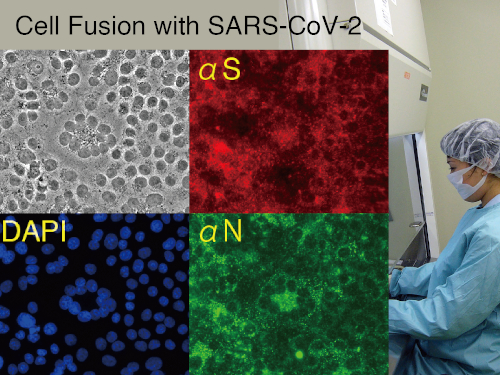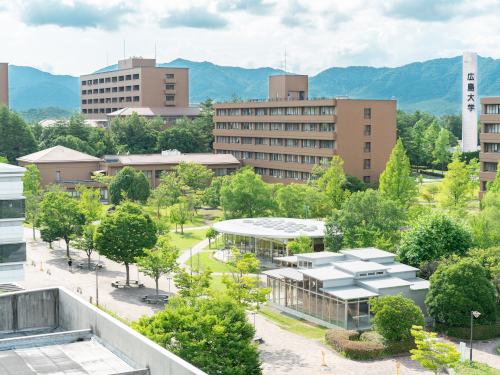By Hiroshima University Department of Public Relations
Therapeutic drugs, a novel test method, a fully automated testing process, and a way to conduct medical diagnosis remotely are just some of the research being done at Hiroshima University to beat COVID-19.
As infections reached a million worldwide last April, Hiroshima University joined the global fight against the pandemic through the “Hiroshima University CoV-Peace-Project.”
A couple of days before October, the world hit another bleak milestone as the number of deaths due to COVID-19 reached one million. It has been nearly nine months since the first known death from the disease, then still an unnamed mysterious viral pneumonia, was recorded. And there are still a lot of unknowns with COVID-19 and the coronavirus causing it.
The virus has upended every aspect of daily life, including how we work and study. Like in other universities, the pandemic had impacted major events at Hiroshima University such as the entrance and graduation ceremonies, which had to be simplified due to crowd restrictions, while classes were moved online. Laboratories at the university also had to deal with partial lockdowns.
RELATED: Read about the many ways the university has responded to the pandemic
Last April, as infections reached a million, the university joined the global fight against the pandemic through the “Hiroshima University CoV-Peace-Project.” Many laboratories at the university started working on treatments and innovations to help us better take care of each other and beat the virus. The university is currently awaiting approval of two patent applications for COVID-19 therapeutic drugs.
Future of disinfection
In September, one of the laboratories at HU has released its study results which provided the first proof that Far-UVC or Ultraviolet C light at a wavelength of 222 nm effectively kills SARS-CoV-2, the virus that causes COVID-19. As previous researches have shown that Far-UVC poses minimal health risks to human skin or eyes, it could be a promising disinfection tool for occupied public spaces.
Dr. Hiroki Kitagawa, an infectious disease specialist at Hiroshima University Hospital and co-author of the study, said they are now verifying the potency of Far-UVC in zapping the virus in clinical settings such as patient rooms.
The Far-UVC research was one of the four studies at the university funded by the Japan Agency for Medical Research and Development (AMED).

The photo shows cell fusion with SARS-CoV-2
Fully automated testing
Another AMED-funded study the university is working on is the development of a fully automated coronavirus testing system that will produce a rapid and accurate diagnosis of coronaviruses. The system will automate both the pre-processing of clinical samples and PCR testing.
Dr. Hidetoshi Tahara from the Graduate School of Biomedical and Health Sciences is heading the project that can potentially reduce waiting time for results, allow testing of multiple samples, and offer insights on the virus' evolution by mutation and phylogenetic analysis using next generation sequencer. By minimizing the need for human interaction, this technology can also prevent infection risks of health care professionals.
New testing method
One study that received a JPY 49 million grant from AMED is looking into a new way of testing for COVID-19 via saliva samples. HU virologist Dr. Takemasa Sakaguchi is leading this research using lectins, a protein that binds to glycans — high mannose sugars that serve as markers of pathogens.
He hopes this novel testing method would be used in detecting SARS-CoV-2 and influenza viruses which are expected to spread simultaneously in winter.
Reducing risks to healthcare providers
Minimizing infection risk to health workers while providing real-time medical diagnosis is the focus of another AMED-funded study.
Dr. Nobuaki Shime of the Department of Emergency and Critical Care Medicine at the university’s Graduate School of Biomedical and Health Sciences is developing a system for healthcare providers to conduct auscultation and analysis of respiratory sounds remotely.
HU is also providing scientific advice as part of a technical committee that helps Hiroshima Prefecture enact its pandemic protocols.
(Research news authored by Mikas Matsuzawa)
Media Contact
Inquiries on the study
Graduate School of Biomedical and Health Sciences
Professor Takemasa Sakaguchi
tsaka * hiroshima-u.ac.jp
(Note: Please replace * with @)
Inquiries on the story
Hiroshima University Department of Public Relations
TEL: 082-424-3701
koho * office.hiroshima-u.ac.jp
(Note: Please replace * with @)

 Home
Home





